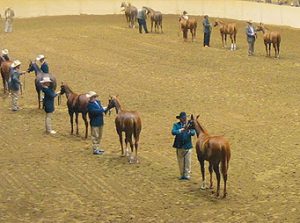Halter Help! – Avoiding Problems in the Pen
Click here to read the complete article284 – October, 2018
By Rachel Kooiker
 Prepping for a major event like the Quarter Horse Congress means thinking about how to achieve picture perfect presentation when you step into the ring. For Halter exhibitors, this involves keeping yourself and your horse calm in busy chutes and warm-up pens, tracking multiple times through a distracting arena, and presenting your horse at its peak conformation for what might be well over an hour of judging. Rules indicate that you can’t talk or communicate inside the show pen, and these rules extend to the coaches and trainers outside of the arena too. So, how do Halter trainers help their clients inside the pen?
Prepping for a major event like the Quarter Horse Congress means thinking about how to achieve picture perfect presentation when you step into the ring. For Halter exhibitors, this involves keeping yourself and your horse calm in busy chutes and warm-up pens, tracking multiple times through a distracting arena, and presenting your horse at its peak conformation for what might be well over an hour of judging. Rules indicate that you can’t talk or communicate inside the show pen, and these rules extend to the coaches and trainers outside of the arena too. So, how do Halter trainers help their clients inside the pen?
DO YOUR HOMEWORK
In Halter competition, it isn’t about just teaching a horse to set up square. Talk to any winning Halter trainer and you’ll quickly realize that it requires something else to make it through a tough Halter class. While at home, you need to expose both horses and handlers to the sights and sounds they will encounter in the show ring. Unless you do that, all of the time you poured into preparation will go to waste as your gorgeous Halter horse becomes a prancing, wiggling, over-stimulated bundle of muscle at the end of your lead. Since any horse will tend to get nervous and excitable in new environments, don’t head to the show pen without doing your homework. Get your horse in the show arena as much as possible.
“The biggest thing in keeping everybody calm in the makeup pen is that exhibitors, the day before, work with their horses,” says AQHA Professional Horseman Ross Roark. “I’ve always found that calms their nerves quite a bit the day of the show. I like to work the day before for 15-30 minutes, or whatever it takes, and that seems to help them on the day of the show.” Fellow horse trainer Todd Grant says, “Years ago, we didn’t think we needed to practice as much, but people have gotten so skilled that the person who takes the time to practice is going to do a superior job. It’s a lot better experience when you practice. For trainers, it’s very important that we do our job at home. They’re big, strong animals, so we do our job at home so that it’s a better experience [for the exhibitor] at the show.” Roark concurs, “My job is to have that horse under control for that exhibitor. I think clients need to handle their horses, and my horses are all broke to be able to have an exhibitor take hold of them and make them show. In the show pen, there are some things you can’t control; but, it’s my job to have that horse walk to the judge in a mannerly way, trot by, and stand while being presented to the judges.”
Click here to read the complete article284 – October, 2018










